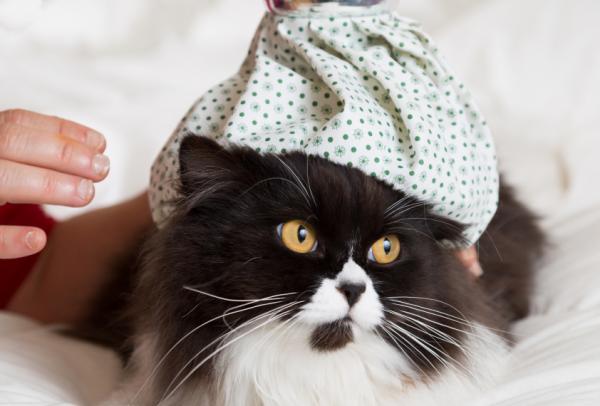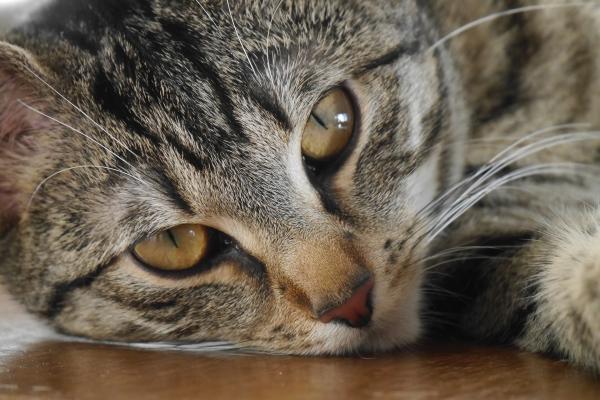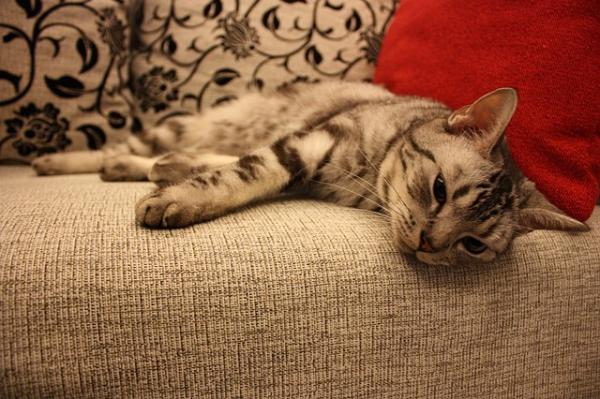Most common diseases in cats

If you are the owner of a cat or you are thinking about welcoming one in your family you should inform yourself of many important things for your care. Among the most important things that we should have a knowledge base to attend to our feline properly, are the diseases that this may suffer.
In this new article we are going to tell you what are the most common diseases of cats. We remind you that the best way to prevent any of these diseases is to keep the vet visits up to date and comply with the vaccination.
The most common serious diseases in cats
Like any living being, cats can also suffer from various diseases, some more serious than others. It turns out that in the case of cats, the vast majority of these diseases are caused by different viruses. Fortunately, with the right prevention, many can be avoided, because for some there are already vaccines.
Next we will comment on the most common serious diseases that felines suffer:
Feline leukemia
It is a viral disease of cats produced by an oncovirus, that is, it is a type of cancer, which is transmitted by contact with body fluids. For example, in cats fights there is usually some wound that bleeds, when they groom and lick each other they contact with the saliva of others, if they share the sandbox they can get in contact with the urine and feces of other cats , a mother who suckles the offspring if infected can pass the virus through milk, among more possible forms of transmission by fluid contact. This sickness usually affects more small kittens and young people It is common in large groups of cats as breeding places and street colonies. It is one of the most serious diseases because of its ease of transmission and the extent of the damage it causes, including death. Tumors occur in different organs of the body of the affected feline and have increased nodes, anorexia, weight loss, anemia and depression among more symptoms. The best way to prevent this viral disease is vaccination and prevent our cat from coming into contact with possible individuals already sick.
Feline panleukopenia
This feline disease is caused by a parvovirus, which in some way is related to the canine parvovirus. It is also known as feline distemper, enteritis or infectious gastroenteritis. The contagion occurs by contact with bodily fluids of an infected cat. Its most common symptoms are fever and later hypothermia, vomiting, diarrhea, depression, weakness, dehydration, anorexia and when performing blood tests we discover an important lowering of leukocytes and / or white blood cells. This viral disease affects kittens and young cats more severely. The treatment basically consists of intravenous hydration and antibiotics among more things necessary depending on how advanced the disease is and the state of the sick cat. This disease is deadly and that is why we must quickly separate any cat that we know is sick from others that can remain healthy. Prevention consists of vaccination and avoiding contact with other cats that may already be sick.
Feline rhinotracheitis
In this case the virus that causes this disease is a herpesvirus. The virus lodges in the airways causing infections in the respiratory system. Among an 45-50% of respiratory diseases in cats are caused by this virus. It especially affects unvaccinated young cats. Symptoms include fever, sneezing, nasal mucus, conjunctivitis, tearing and even ulcers in the cornea. It is spread by contact with fluids such as nasal secretions and saliva. This disease can be prevented with adequate vaccination. There is no specific treatment for this disease so its symptoms are treated. The cats that heal become carriers because they no longer suffer from the symptoms but they continue to harbor the virus and can infect other individuals. The best thing is prevention with vaccination.
Calicivirosis or feline calicivirus
This feline viral disease is caused by a picornavirus. Symptoms include sneezing, fever, a lot of salivation and even ulcers and blisters in the mouth and tongue. It is a very widespread disease with a high morbidity. It is the cause of an 30% – 40% of cases of respiratory infections in cats. The affected animal that manages to overcome the disease, will remain as a carrier for life and therefore can spread this disease.
Feline pneumonitis
This disease is produced by a microorganism known as Chlamydia psittaci that produces a series of infections known as chlamydiosis which are characterized in cats by rhinitis and conjunctivitis. These microorganisms are intracellular parasites that are spread by direct contact with fluids and bodily secretions. It is not a disease by itself fatal, but to avoid complications which could end in death of the feline should go as soon as possible to the veterinarian to start a treatment. Feline pneumonitis, along with calicivirosis and feline rhinotracheitis form the known feline respiratory complex. The symptoms of feline pneumonitis are excessive tearing, conjunctivitis, reddened and painful eyelids, ocular discharge is abundant and may be yellowish or greenish, plus sneezing, fever, cough, nasal mucus and lack of appetite among more symptoms. The treatment should be based on antibiotics as well as eye cleanings with special drops, rest, high carbohydrate diet and in case fluid therapy with serum is necessary. As in most diseases, the best prevention will be to keep vaccines up to date and avoid contact with cats that may suffer from this disease and infect it.
Feline immunodeficiency
The virus that causes this disease is the lentivirus. We commonly know this disease as feline AIDS. Its transmission usually happens in fights and during the reproduction since it is given by bite of a sick cat to another one. It greatly affects unsterilized adult cats. The symptoms that will make us suspect this disease are an absolute depression of the immune system and opportunistic secondary diseases. These secondary diseases are usually those that ultimately cause death to the affected cat. Work is being done to find a reliable vaccine, but there are cats that develop resistance to this disease because they are in contact with sick cats.
Infectious peritonitis
In this case the virus that causes the disease is a coronavirus that affects more young specimens and occasionally older ones. its contagion it is given, above all, through the feces of infected cats and when a healthy cat sniffs them the virus is introduced through the respiratory tract. It occurs most commonly in areas with many cats as protectors, hatcheries, colonies and other places where there are large numbers of cats living together. The most notable symptoms are fever, anorexia, increased volume of the abdomen and accumulation of fluid in it. This is because the virus attacks the white blood cells causing inflammation in the membranes of the thoracic and abdominal cavities. If it occurs in the pleura, it produces pleuritis and if it affects the peritoneum it produces peritonitis. There is vaccination against this disease, but once contracted there is no cure and it is deadly, so it is better to follow the vaccination protocols and avoid that our cat can get it. Symptomatic supportive treatment can only be administered to alleviate the pain and discomfort suffered by the cat. The best prevention is to have the vaccination up to date, avoid situations that weaken our cat and cause stress and prevent it from being related to cats that may be sick.
This disease that causes a virus is widespread throughout the world and is transmitted between various species of mammals, including humans, so it is a zoonosis. It is spread through the saliva inoculated with the bite of one infected animal to another. Luckily it is eradicated or at least controlled in many areas of the world since there is reliable vaccination, being mandatory in several countries.

Other common health problems in domestic cats
In the previous section we talked about the most serious major diseases, but we also want to comment other health problems and diseases also common and important that cats can suffer:
- Allergies As happens to us, cats also suffer from allergies of very different origins. You can consult this article to know more about the allergy in cats, its symptoms and treatment.
- Conjunctivitis. Cats are delicate eye health, so they have conjunctivitis easily. You can read here all about conjunctivitis in cats, its causes and symptoms.
- Periodontal disease. This disease that occurs in the mouth of our cat is common especially in older cats and if not treated early can be fatal. You can also consult tips to remove tartar in cats on our website.
- Otitis. Otitis is not only very common in dogs, in cats it is one of the most frequently solvable health problems. You can consult this article to know everything about otitis in cats.
- Obesity and overweight. Obesity is a very common problem in domestic cats today. See all about how to prevent obesity in cats.
- Colds The common cold among cats even if it is only due to a current of air is also very frequent in these small furry ones. In this article you will be able to consult home remedies for the cold of the cat in case you think that yours could be.
- Poisoning. The poisoning in cats is more frequent than it may seem and it is a problem for the health of our very serious feline. Here you can see everything about poisoning in cats, their symptoms and first aid.

General prevention against feline diseases
As we discussed at the beginning of this article, the most important thing to prevent our cat suffering from any of these diseases is the regular prevention of the agents that can cause them. We must go to the veterinarian on a regular basis and whenever we detect any symptom or anything that does not fit with the normal behavior of our cat.
We will respect the vaccination schedule, it is vital that our cat is vaccinated since the vaccines that are provided are precisely for some common and very serious diseases.
It is vital that we maintain a deworming both internally and externally. In the case of internal deworming there are products such as pills, tablets and other chews with the appropriate antiparasitic dose for cats. For external deworming we have sprays, pipettes or spot-on and collars. We will never use any of these products that are not specifically made for cats. Well, we must think that no matter how much we give less dose than the one indicated for dogs of a product of the aforementioned, it is quite probable that we intoxicate our cat unintentionally.
Finally, we must avoid the contact of our feline with others of whom we do not know their health status, especially if their appearance already makes us suspect some symptoms of possible problems and diseases.

This article is merely informative, in .com we do not have the faculty to prescribe veterinary treatments or make any kind of diagnosis. We invite you to take your pet to the veterinarian in case of any type of condition or discomfort.
If you want to read more articles similar to Most common diseases in cats, we recommend that you enter in our Prevention section.


